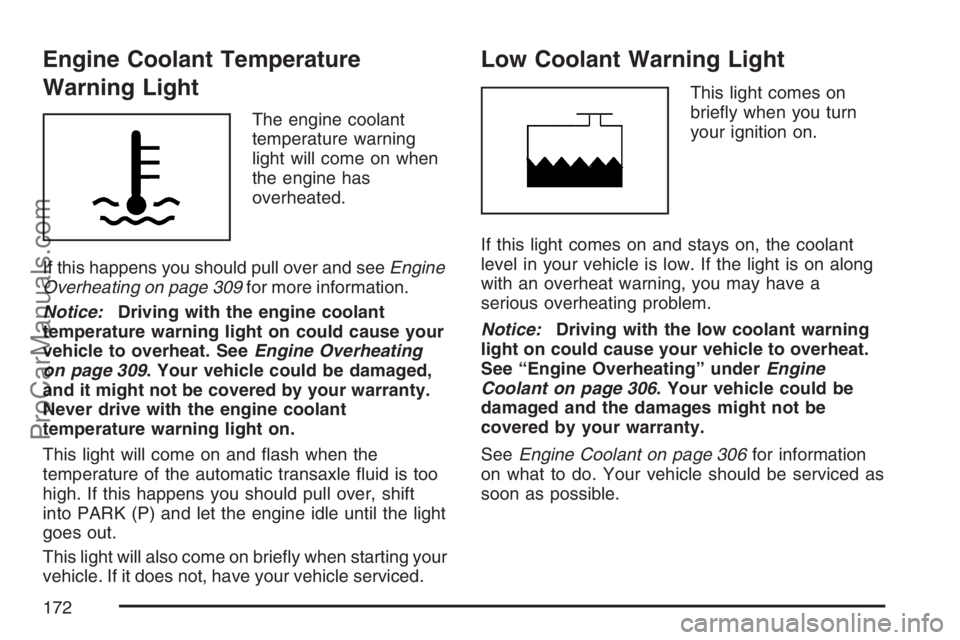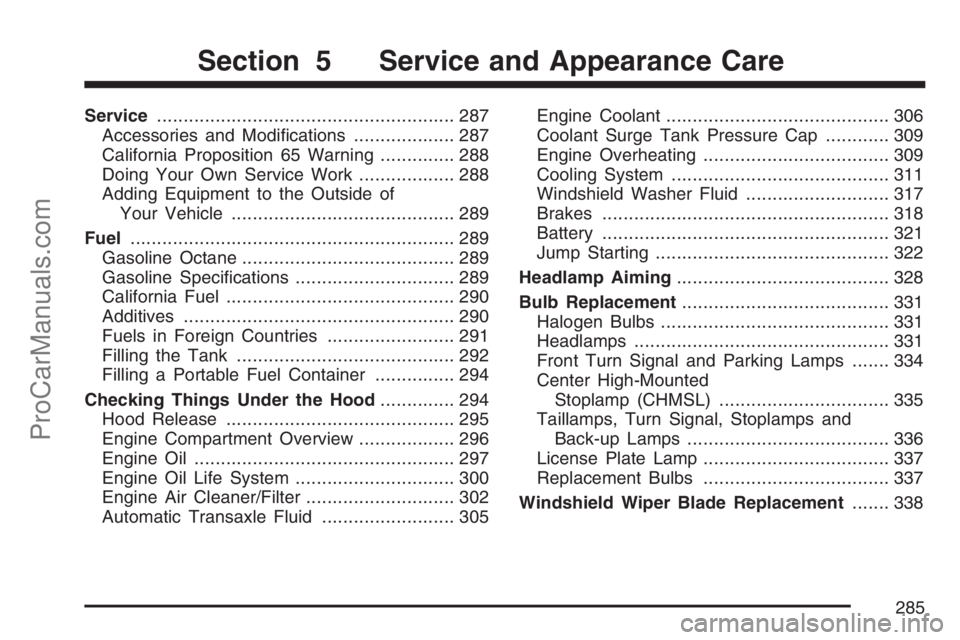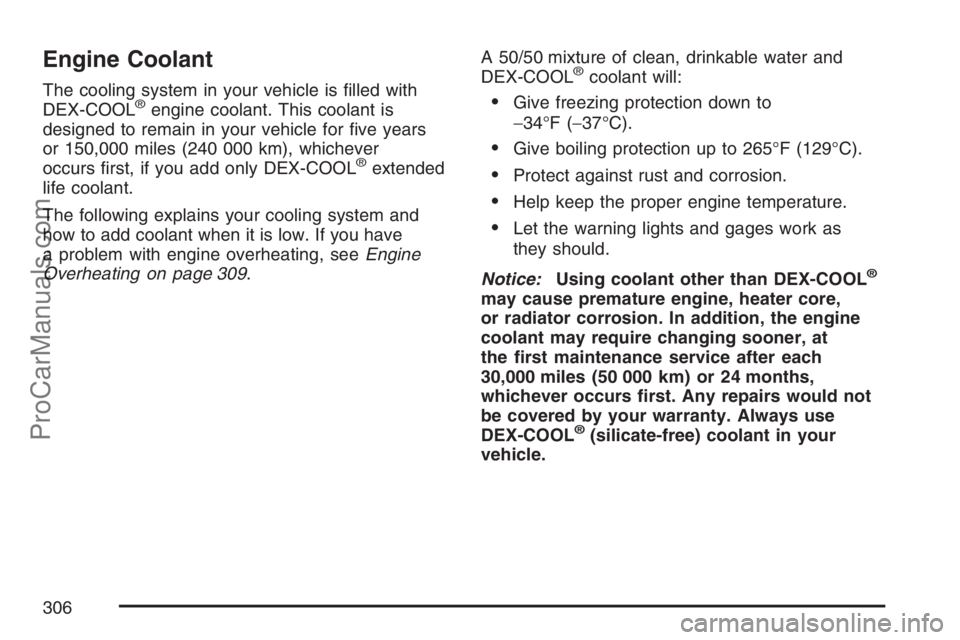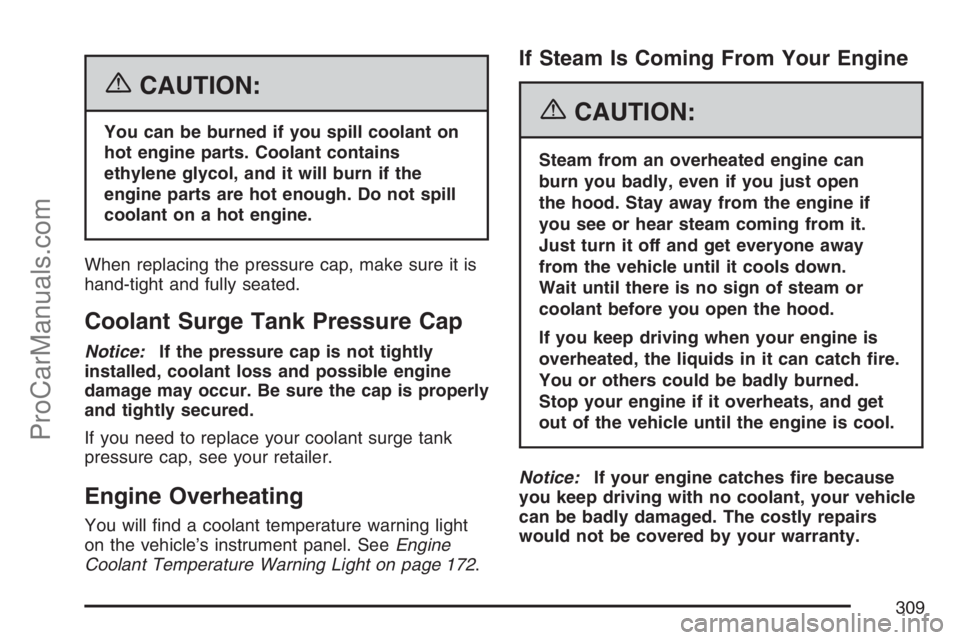overheating SATURN VUE HYBRID 2007 Owners Manual
[x] Cancel search | Manufacturer: SATURN, Model Year: 2007, Model line: VUE HYBRID, Model: SATURN VUE HYBRID 2007Pages: 438, PDF Size: 2.83 MB
Page 155 of 438

Notice:Leaving electrical equipment on for
extended periods will drain the battery. Always
turn off electrical equipment when not in use
and do not plug in equipment that exceeds the
maximum 20 ampere rating.
Certain electrical accessories may not be
compatible with the accessory power outlet and
could result in blown vehicle or adapter fuses.
If you experience a problem, see your retailer for
additional information on the accessory power
outlet.
Notice:Adding any electrical equipment to
your vehicle may damage it or keep other
components from working as they should.
The repairs would not be covered by your
warranty. Check with your retailer before
adding electrical equipment.
When adding electrical equipment, be sure to
follow the installation instructions included with the
equipment.
Notice:Improper use of the power outlet can
cause damage not covered by your warranty.
Do not hang any type of accessory or
accessory bracket from the plug because the
power outlets are designed for accessory
power plugs only.Cigarette Lighter
Your vehicle may have a cigarette lighter. To use
the lighter, located on the instrument panel below
the climate controls, push it in all the way and let
go. When it is ready, it will pop back out by itself.
Notice:Holding a cigarette lighter in while it is
heating does not let the lighter back away
from the heating element when it is hot.
Damage from overheating can occur to the
lighter or heating element, or a fuse could be
blown. Do not hold a cigarette lighter in while it
is heating.
Notice:If you put papers, pins, or other
�ammable items in the ashtray, hot cigarettes
or other smoking materials could ignite
them and possibly damage your vehicle.
Never put �ammable items in the ashtray.
155
ProCarManuals.com
Page 172 of 438

Engine Coolant Temperature
Warning Light
The engine coolant
temperature warning
light will come on when
the engine has
overheated.
If this happens you should pull over and seeEngine
Overheating on page 309for more information.
Notice:Driving with the engine coolant
temperature warning light on could cause your
vehicle to overheat. SeeEngine Overheating
on page 309. Your vehicle could be damaged,
and it might not be covered by your warranty.
Never drive with the engine coolant
temperature warning light on.
This light will come on and �ash when the
temperature of the automatic transaxle �uid is too
high. If this happens you should pull over, shift
into PARK (P) and let the engine idle until the light
goes out.
This light will also come on brie�y when starting your
vehicle. If it does not, have your vehicle serviced.
Low Coolant Warning Light
This light comes on
brie�y when you turn
your ignition on.
If this light comes on and stays on, the coolant
level in your vehicle is low. If the light is on along
with an overheat warning, you may have a
serious overheating problem.
Notice:Driving with the low coolant warning
light on could cause your vehicle to overheat.
See “Engine Overheating” underEngine
Coolant on page 306. Your vehicle could be
damaged and the damages might not be
covered by your warranty.
SeeEngine Coolant on page 306for information
on what to do. Your vehicle should be serviced as
soon as possible.
172
ProCarManuals.com
Page 282 of 438

Driving on Grades
Notice:Do not tow on steep continuous
grades exceeding 6 miles (9.6 km). Extended,
higher than normal engine and transaxle
temperatures may result and damage your
vehicle. Frequent stops are very important to
allow the engine and transaxle to cool.
Reduce speed and shift to a lower gear before
you start down a long or steep downgrade. If you
don’t shift down, you might have to use your
brakes so much that they would get hot and no
longer work well.
On a long uphill grade, shift down and reduce
your speed to around 45 mph (70 km/h) to reduce
the possibility of the engine and the transaxle
overheating. If your engine does overheat,
seeEngine Overheating on page 309.
Parking on Hills
{CAUTION:
You really should not park your vehicle,
with a trailer attached, on a hill.
If something goes wrong, your rig could
start to move. People can be injured, and
both your vehicle and the trailer can be
damaged.
But if you ever have to park your rig on a hill,
here’s how to do it:
1. Apply your regular brakes, but don’t shift into
PARK (P).
When parking uphill, turn your wheels away
from the curb. When parking downhill,
turn your wheels into the curb.
2. Have someone place chocks behind the
trailer wheels.
282
ProCarManuals.com
Page 284 of 438

Engine Cooling When Trailer Towing
Your cooling system may temporarily overheat
during severe operating conditions. SeeEngine
Overheating on page 309.
Changing a Tire When Trailer Towing
If you get a �at tire while towing a trailer, be
sure to secure the trailer and disconnect it from
the vehicle before changing the tire.
Trailer Wiring
Additional wire length has been provided for
connecting trailer wiring to your vehicle. A loop of
�ve wires is located in the storage compartment on
the driver’s side of the cargo area. The wires are
fused in both the underhood and instrument fuse
block. SeeInstrument Panel Fuse Block on
page 381andUnderhood Fuse Block on page 382.The wires do not have a connector and should be
wired to the trailer by a quali�ed electrical
technician. The technician can use the following
information when connecting a trailer wiring
harness to your vehicle.
Yellow: Left Turn Signal
Brown: Parking Lamps
Light Blue: Stop Lamps
Black: Ground Wire
Dark Green: Right Turn Signal
When connecting a trailer harness, be sure you
leave it loose enough so the wiring does not bend
or break, but not so loose that it drags on the
ground. Store the harness in the storage
compartment on the driver’s side of the cargo area
when the harness is not in use. Wrap the harness
together and tie it neatly so it will not be damaged.
284
ProCarManuals.com
Page 285 of 438

Service........................................................ 287
Accessories and Modi�cations................... 287
California Proposition 65 Warning.............. 288
Doing Your Own Service Work.................. 288
Adding Equipment to the Outside of
Your Vehicle.......................................... 289
Fuel............................................................. 289
Gasoline Octane........................................ 289
Gasoline Speci�cations.............................. 289
California Fuel........................................... 290
Additives................................................... 290
Fuels in Foreign Countries........................ 291
Filling the Tank......................................... 292
Filling a Portable Fuel Container............... 294
Checking Things Under the Hood.............. 294
Hood Release........................................... 295
Engine Compartment Overview.................. 296
Engine Oil................................................. 297
Engine Oil Life System.............................. 300
Engine Air Cleaner/Filter............................ 302
Automatic Transaxle Fluid......................... 305Engine Coolant.......................................... 306
Coolant Surge Tank Pressure Cap............ 309
Engine Overheating................................... 309
Cooling System......................................... 311
Windshield Washer Fluid........................... 317
Brakes...................................................... 318
Battery...................................................... 321
Jump Starting............................................ 322
Headlamp Aiming........................................ 328
Bulb Replacement....................................... 331
Halogen Bulbs........................................... 331
Headlamps................................................ 331
Front Turn Signal and Parking Lamps....... 334
Center High-Mounted
Stoplamp (CHMSL)................................ 335
Taillamps, Turn Signal, Stoplamps and
Back-up Lamps...................................... 336
License Plate Lamp................................... 337
Replacement Bulbs................................... 337
Windshield Wiper Blade Replacement....... 338
Section 5 Service and Appearance Care
285
ProCarManuals.com
Page 306 of 438

Engine Coolant
The cooling system in your vehicle is �lled with
DEX-COOL®engine coolant. This coolant is
designed to remain in your vehicle for �ve years
or 150,000 miles (240 000 km), whichever
occurs �rst, if you add only DEX-COOL
®extended
life coolant.
The following explains your cooling system and
how to add coolant when it is low. If you have
a problem with engine overheating, seeEngine
Overheating on page 309.A 50/50 mixture of clean, drinkable water and
DEX-COOL
®coolant will:
Give freezing protection down to
−34°F (−37°C).
Give boiling protection up to 265°F (129°C).
Protect against rust and corrosion.
Help keep the proper engine temperature.
Let the warning lights and gages work as
they should.
Notice:Using coolant other than DEX-COOL
®
may cause premature engine, heater core,
or radiator corrosion. In addition, the engine
coolant may require changing sooner, at
the �rst maintenance service after each
30,000 miles (50 000 km) or 24 months,
whichever occurs �rst. Any repairs would not
be covered by your warranty. Always use
DEX-COOL
®(silicate-free) coolant in your
vehicle.
306
ProCarManuals.com
Page 308 of 438

Checking Coolant
The surge tank is located on the driver’s side
of the engine compartment. SeeEngine
Compartment Overview on page 296for more
information on location.
{CAUTION:
Turning the surge tank pressure cap when
the engine and radiator are hot can allow
steam and scalding liquids to blow out
and burn you badly. Never turn the surge
tank pressure cap — even a little — when
the engine and radiator are hot.
The vehicle must be on a level surface. When
your engine is cold, the coolant level should be
at the COLD FILL line. When your engine is warm,
the level should be at the COLD FILL line or a
little higher.
Adding Coolant
If you need more coolant, add the proper
DEX-COOL®coolant mixture at the surge tank,
but only when the engine is cool. SeeEngine
Overheating on page 309for instructions on
“How to Add Coolant to the Coolant Surge Tank.”
308
ProCarManuals.com
Page 309 of 438

{CAUTION:
You can be burned if you spill coolant on
hot engine parts. Coolant contains
ethylene glycol, and it will burn if the
engine parts are hot enough. Do not spill
coolant on a hot engine.
When replacing the pressure cap, make sure it is
hand-tight and fully seated.
Coolant Surge Tank Pressure Cap
Notice:If the pressure cap is not tightly
installed, coolant loss and possible engine
damage may occur. Be sure the cap is properly
and tightly secured.
If you need to replace your coolant surge tank
pressure cap, see your retailer.
Engine Overheating
You will �nd a coolant temperature warning light
on the vehicle’s instrument panel. SeeEngine
Coolant Temperature Warning Light on page 172.
If Steam Is Coming From Your Engine
{CAUTION:
Steam from an overheated engine can
burn you badly, even if you just open
the hood. Stay away from the engine if
you see or hear steam coming from it.
Just turn it off and get everyone away
from the vehicle until it cools down.
Wait until there is no sign of steam or
coolant before you open the hood.
If you keep driving when your engine is
overheated, the liquids in it can catch �re.
You or others could be badly burned.
Stop your engine if it overheats, and get
out of the vehicle until the engine is cool.
Notice:If your engine catches �re because
you keep driving with no coolant, your vehicle
can be badly damaged. The costly repairs
would not be covered by your warranty.
309
ProCarManuals.com
Page 312 of 438

The coolant level should be at the COLD FILL
line. If it is not, you may have a leak at the radiator
hoses, heater hoses, radiator, water pump, or
somewhere else in the cooling system.
{CAUTION:
Heater and radiator hoses, and other
engine parts, can be very hot. Do not
touch them. If you do, you can be burned.
Do not run the engine if there is a leak.
If you run the engine, it could lose all
coolant. That could cause an engine �re,
and you could be burned. Get any leak
�xed before you drive the vehicle.If there seems to be no leak, with the engine on,
check to see if the electric engine cooling fan
is running. If the engine is overheating, the
fan should be running. If it is not, your vehicle
needs service. Turn off the engine.
Notice:Engine damage from running your
engine without coolant is not covered by
your warranty.
Notice:Using coolant other than DEX-COOL®
may cause premature engine, heater core,
or radiator corrosion. In addition, the engine
coolant could require changing sooner, at
30,000 miles (50 000 km) or 24 months,
whichever occurs �rst. Any repairs would not
be covered by your warranty. Always use
DEX-COOL
®(silicate-free) coolant in your
vehicle.
312
ProCarManuals.com
Page 339 of 438

Tires
Your new vehicle comes with high-quality tires
made by a leading tire manufacturer. If you ever
have questions about your tire warranty and where
to obtain service, see your Saturn Warranty
booklet for details. For additional information refer
to the tire manufacturer’s booklet included with
your vehicle.
{CAUTION:
Poorly maintained and improperly used
tires are dangerous.
Overloading your vehicle’s tires can
cause overheating as a result of too
much friction. You could have an
air-out and a serious accident. See
Loading Your Vehicle on page 264.
CAUTION: (Continued)
CAUTION: (Continued)
Underin�ated tires pose the same
danger as overloaded tires. The
resulting accident could cause serious
injury. Check all tires frequently to
maintain the recommended pressure.
Tire pressure should be checked when
your vehicle’s tires are cold. See
Inflation - Tire Pressure on page 345.
Overin�ated tires are more likely to be
cut, punctured, or broken by a sudden
impact — such as when you hit a
pothole. Keep tires at the
recommended pressure.
Worn, old tires can cause accidents.
If the tire’s tread is badly worn,
or if your vehicle’s tires have been
damaged, replace them.
339
ProCarManuals.com